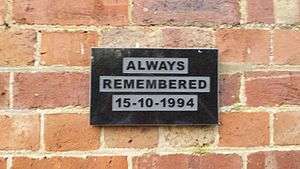Cowden rail crash
 | |
| Date | 15 October 1994 |
|---|---|
| Location | Cowden railway station, Kent |
| Country | England |
| Rail line | Oxted Line |
| Operator | Network SouthCentral |
| Type of incident | Single-line collision |
| Cause | SPAD caused by driver error |
| Statistics | |
| Trains | 2 |
| Deaths | 5 |
| Injuries | 13 |
| List of UK rail accidents by year | |
The Cowden rail crash occurred on 15 October 1994, around 400 yards southeast of Cowden Station in the English county of Kent. There was a head-on collision between two trains in heavy fog after a northbound train passed a signal at danger without authority and entered a single line section.
Five people were killed and thirteen were injured. The guard of the northbound train, Jonathan Brett-Andrews, had ambitions to become a driver and was in the driver's cab at the time of the collision; this was in breach of the operating rules. It is thought that his presence may have contributed to the accident and there were even suspicions that he might have been at the controls; he had been reprimanded twice before for driving trains[1] when he should not have. Both he and the driver were killed in the collision, and the front ends of both trains were so badly damaged that it was not possible to ascertain the exact positions of the crew in the northbound train at the point of impact. Two passengers – a couple travelling in the leading coach of the northbound train – were also killed.
There were several other contributory factors; it was conjectured that the AWS may have been inoperative (though the official report considers this unlikely), the signal was dirty and the light intensity was low, and there were no trap points to prevent a train wrongly entering a section against the signal. However the official report blamed the driver of the northbound train, Brian Barton.
It was noted that the Oxted signalman, who was aware of the situation, had no direct means of alerting either driver. He attempted to contact the driver of the down train on the signal post telephone, but to no avail (presumably the driver never heard it above the noise of the engine immediately behind him). The signalman did alert the emergency services to the collision while the trains were still one mile apart. The reason for cancelling the contract to fit Cab Secure Radio to this line prior to the incident (in the wake of the previous Clapham disaster and Hidden report recommendations) remains unclear; however it seems likely that the changes occurring at the time (Channel Tunnel and privatisation of the Network) took priority over funding. Cab Secure Radio began to be installed across the railway immediately following the incident, and an inquiry was started.
The accident was exacerbated by the age and design of the multiple units involved. The separate-chassis construction of the elderly British Rail Class 205 stock, based on the BR Mk1 design, led to overriding of one carriage by the next. The weight of the diesel engines above the frames of the coach probably did not help. These trains, unpopular with users of the line because of their antiquated nature, were replaced in 2004 by Turbostars.
The Wealden Line Campaign, which lobbies for service improvements and extensions to the Uckfield Line, had previously predicted within their newsletter "Missing Link" (and via the local press) that the line's "rationalisation" (reduction to single line sections) could lead to such an event. They continue to campaign for the re-doubling of the route and its development within their "BML2" project.
A plaque on the station buildings at Cowden commemorates the accident.
Legacy

- Cab Secure Radio began to be introduced
- SPAD indicators were introduced to protect the entrance to single lines
- AWS magnets were installed at the exits to some Maintenance depots to check that a train's Automatic warning system is operational.[2]
- Eventually the Train protection and warning system was installed at the entrance to Single lines and other conflict points.
References
- ↑ https://www.independent.co.uk/news/train-crash-driver-impossible-to-identify-1318020.html
- ↑ "Rulebook Master: AWS and TPWS Handbook. Section 1.2 "Depot test magnet: A permanent magnet, used to test the operation of a train's AWS equipment, may be provided at the exit of certain maintenance depots."" (pdf). Network Rail. Retrieved 2017-11-02.
Sources
- Hall, Stanley (1999). Hidden Dangers. Ian Allan. ISBN 0-7137-1973-7.
- Holden, C. B. (January 1996). "A report of the Inquiry into the collision between two passenger trains which occurred at Cowden on 15 October 1994" (PDF). Health and Safety Executive. Retrieved 23 January 2011.
- Vaughan, Adrian (2000). Tracks to Disaster. Ian Allan. ISBN 0-7110-2731-5.